Do you know where the B2B marketing industry is heading? Because if you don’t, you won’t know how to improve your own B2B marketing strategy.
The B2B marketing world is dynamic — technology, trends, and tactics are ever-changing. That’s why your business must stay updated on new industry developments.
Marketing to a business is quite different from marketing to an individual consumer. That’s why we built this guide to help you have a better understanding of:
- What Is B2B Marketing?
- B2B Marketing Strategies and Tactics
- B2B Email Marketing
- B2B Email Marketing Best Practices
- B2B Digital Marketing
- B2B Content Marketing
- B2B Social Media Marketing
- Invest in Business to Business Marketing to Increase Your Customer Base
What Is B2B Marketing?
B2B marketing is any marketing strategy aimed at a company or organization.
The goal of B2B marketing is to generate interest in your brand and nurture prospects to convert them into customers. Ideally, you want other businesses to form a valuable relationship with your brand for many years.
Successful B2B marketing blends traditional and digital marketing tools to help prospects understand what you can do for their business. That will help you market to many companies without losing your personal touch.
For example, when it comes to marketing techniques that B2B companies use, email is top of the list. 84% of respondents have used email as a marketing tactic, most likely because of its high return on investment (ROI).
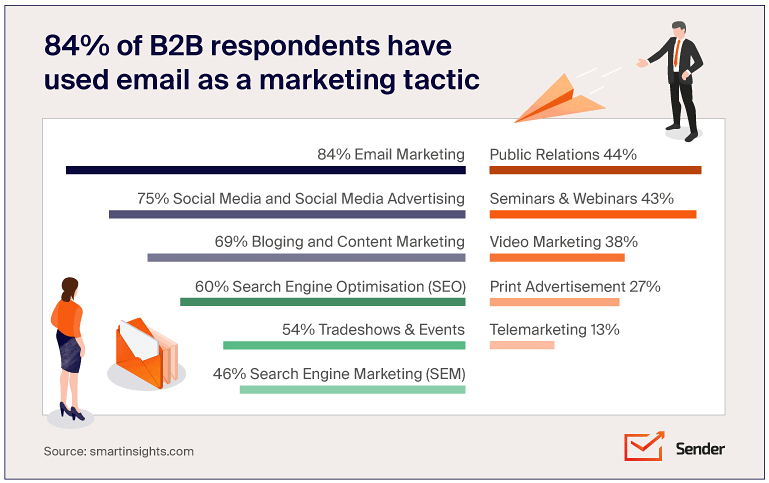
However, 54% of marketers still rely on trade shows and events, proving the value of merging traditional and digital tools to create a well-rounded, data-driven approach to customer engagement and brand positioning.
B2B vs. B2C Marketing
Simply put, B2B marketing targets businesses, while B2C marketing targets individual consumers.
Marketers strive to provide an authentic, customer-centric experience to both B2B and B2C buyers. But each audience requires a unique approach since individual consumers have different buying habits and needs than businesses.
While B2C marketing is concerned with creating enjoyable content and quick solutions, B2B companies focus their marketing efforts on logic and showing a product’s ROI to a business customer.
Here’s an example of B2B and B2C in action:
B2B (business to business) — an email marketing software company that sells its product to a graphic design company.
B2C (business to consumer) — an oral care company that sells toothpaste tubes, toothbrushes, and mouthwash to individuals.
B2B and B2C can intersect at times. One company can have both B2B and B2C initiatives simultaneously.
For example, an interior design company that designs office spaces for companies (a B2B service) might also design various rooms for homebuyers (a B2C service).
Here’s a summary of the differences between B2B and B2C marketing:
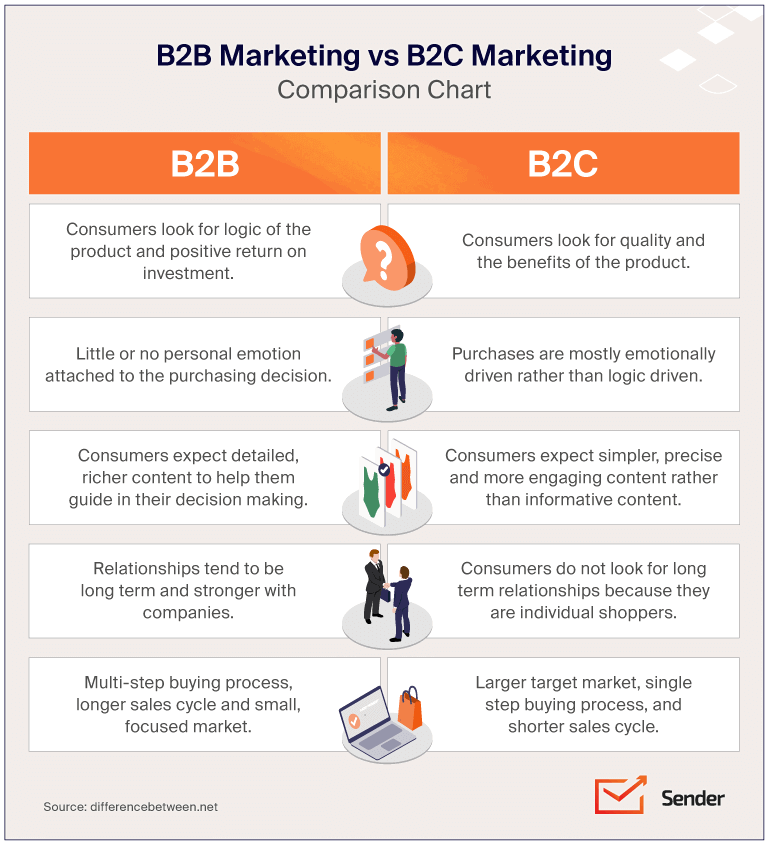
B2B Marketing Strategies
Business-to-business marketing companies have many strategies for increasing B2B lead generation and b2b sales.
But which of these strategies will help you succeed in today’s hyper-competitive environment?
Let’s take a look at five essential B2B marketing tactics that will help your company get ahead of the competition:
- Research your target audience’s pain points
- Understand search engine optimization for B2B
- Use B2B advertising
- Leverage LinkedIn to connect with multiple decision-makers
- Use influencer marketing
1. Research Your Target Audience’s Pain Points
Successful B2B marketing starts by researching your customers’ needs and problems since selling a product or service doesn’t guarantee that customers will come running.
Research is the foundation of any modern marketing effort. From brand research to marketplace research, detailed scientific studies will enable you to make informed decisions. They’ll help you be objective and provide valuable metrics for measuring your results.
Hinge shares that businesses that regularly research their target audience grow up to 10 times faster and are nearly two times more profitable than businesses that don’t.
So, discover what drives demand for your offering and how you can stand out from the competition. To do this, you can:
- Form customer user groups to identify specific pain points your customers are experiencing before looking for a solution.
- Do keyword research to discover organic search demand.
- Leverage existing data about your industry.
Also read: What is Targeted Marketing? Definition, Strategies & Examples
2. Understand Search Engine Optimization for B2B
B2B SEO is a digital marketing strategy that aims to help B2B website pages rank higher in search engines like Google.
Unlike SEO for B2C, B2B SEO focuses on keywords that key decision-makers in organizations search for while at work. And if you’re not a top result for those keywords, they might not even consider you as a potential vendor.
SEO is vital that high-growth firms rank it the most effective online marketing tactic.
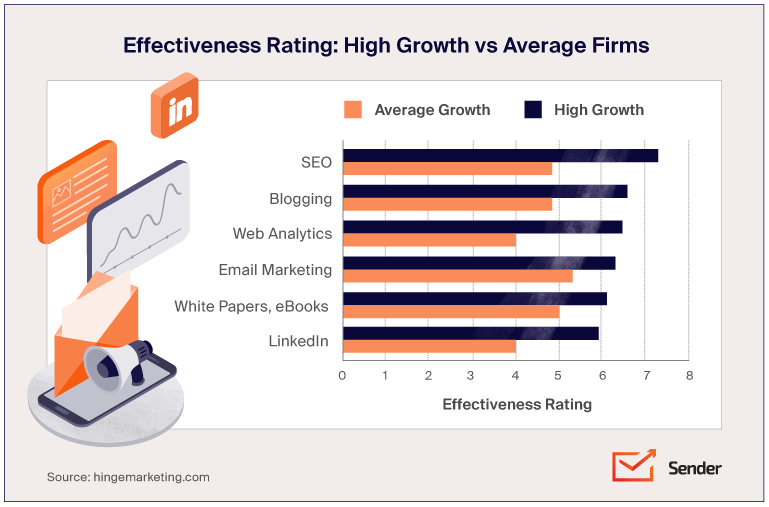
That said, here are five steps for an effective B2B SEO strategy:
- Build your decision-maker persona. This is the person you need to get in front of. Depending on your business, it could be a product manager or a chief financial officer. HubSpot’s free Make My Persona tool can be super helpful for this step.
- Find keywords that decision-makers search to find your product or service. In other words, keywords that they search for when they’re almost ready to buy. You can use Google Analytics or SEO tools like Ahrefs to do this step.
- Optimize your product and services pages. Create unique and long-form content, then insert your target keyword strategically on the page.
- Create a valuable B2B blog. When you consistently publish high-quality content, people see you as the go-to leader in the space. As a result, they’re more likely to buy from you.
- Build backlinks for your B2B website. Focus on industry blogs and news sites. Also, create helpful tools and calculators that people can link to. Or, reach out to business partners and ask them to add your website to their partner pages.
3. Use B2B Advertising
Paid advertising should be part of your B2B marketing strategy. If done correctly, paid B2B marketing services can generate significant ROI for your business.
There are several platforms where your company can advertise effectively. They include:
- Websites and industry publications
- Social media channels like LinkedIn, Twitter, and Facebook
- Retargeting – cookie-based tech that uses a JavaScript code to anonymously “follow” your target audience across the web and serve them relevant ads
That said, it’s crucial to use advertising platforms best suited to B2B businesses. For example, LinkedIn, retargeting, and other industry-specific advertising are the most effective since they enable you to directly target relevant industry audiences, resulting in more conversions and higher click-through rates.
So, a well-designed PPC advertising campaign can help you save a significant amount of money as the value of each click from potential customers exceeds the cost of the click paid to a publisher.
4. Leverage LinkedIn to Connect With Multiple Decision Makers
LinkedIn has quickly grown from a small professional networking website to a massive global force. And marketers have been trying to capitalize on LinkedIn’s ability to connect with key decision-makers in a professional setting.
Every B2B marketing team should be using LinkedIn to reach their audience and drive leads. That’s because LinkedIn is responsible for 97% of a business’s social media leads.
That said, how do you leverage LinkedIn in the best way possible? Here are four tips to help you do that:
- Structure your business page to lead to a conversion action such as a click-through to your website.
- Use LinkedIn’s advanced search to identify the exact type of people you’re targeting.
- Search for your niche groups, join them and be active.
- Publish quality content to turn your strategy from outbound marketing — drawing attention through ads — to inbound marketing, where you attract users interested in what you have to offer.
5. Use Influencer Marketing
In influencer marketing, you use key leaders to drive your brand message to the larger market. Instead of selling directly to a big audience, you can hire market influencers to promote your products or services.
People are more likely to take action based on their peer’s recommendations — and the same goes for the B2B marketing world. So teaming up with influencers can be an effective marketing strategy for your business.
For example, if your SaaS company wants to promote its HR software, you could team up with an influencer that most HR personnel follow. A sample article about the benefits of your software on Matt Charney’s social profiles can be a superb way to generate leads.
If you own a local business, local influencers can be a creative and cost-effective way to boost the effectiveness of your B2B marketing.
B2B Email Marketing
If marketing were a contest, email would be the clear winner.
Email marketing has an ROI of 4200%. Compare that to SEO’s 317% ROI and PPC’s 200% ROI.
Surprisingly, 87% of B2B marketers say email is among the top free organic distribution channels they use?
Email is also the only platform where you control your whole audience.
In any other social media channel such as LinkedIn or Instagram, you leave your audience’s power in the hands of the platform itself. If you were suddenly banned from LinkedIn for no reason (and trust us, it happens), you’d lose your whole audience in a snap.
Like a B2B swiss army knife, you can use email marketing to inform users about your brand, nurture existing leads, generate new leads, convert prospects into customers, and keep current customers engaged.
The key to developing a successful B2B email marketing campaign is careful planning. You need to:
- Define your objectives
- Determine your key performance indicators (KPIs) to measure performance over time
- Create your message map and roadmap
- Launch and execute your marketing plans
- Monitor your results
B2B Email Marketing Best Practices
Email deserves to be the focus of your marketing mix.
But that doesn’t mean you can bang out any old message and send it off. There are do’s and don’ts and best practices.
In the B2B world, you want to keep it professional. But what else can you do in 2022 to improve your B2B email marketing?
Try these three best practices:
- Personalize your B2B emails
- Craft catchy email subject lines that will get people’s attention
- Use a simple call to action (CTA)
Personalize Your B2B Emails
If you treat your clients like faceless names, you won’t get much of a response. Your customers want to feel recognized as individuals and see that you’ve made an effort to learn about them.
“Email has an ability many channels don’t: creating valuable, personal touches — at scale.”
David Newman
You can collect personal info and automatically include it in your B2B email marketing campaign while building your mailing list. The more you personalize, the more effective your message will be.
Also read: Email Personalization: Examples, Statistics & Best Practices
Craft Subject Lines That Will Get People’s Attention
A good subject line can be the difference between your B2B email campaign getting high open rates or ending up in the trash.
Research shows that 64% of users open an email based on the subject line.
So how do you craft good subject lines for B2B emails?
Pretty much the same way you would for individual customers: Understanding what language causes curiosity and striking the heart of your audience’s wants.
While the nature of your audience largely determines what will or won’t work, here are some more guidelines to help you improve your B2B email subject lines:
- Remove all spam words and symbols from your subject line
- Aim for 28 to 39 characters to cater to mobile users
- Use at least one emoji in your subject line
Use shorter subject lines initially, then try out some longer ones later on to see which performs best. Once you get the proper range, stick with it.
Use a Simple Call to Action (CTA)
Your emails need to do more than just remind customers that you exist.
You can include a call to action to visit your landing page or give customers some options to continue the conversation with you.
Keep it simple and low on commitment. Nudge your customers to do something for their benefit, not yours.
That said, having a call-to-action section in your email templates won’t suffice. The context in which you present it also matters.
In other words, your copywriting will determine whether new customers will follow through on the action you’re encouraging. So keep your message short. Skip the lengthy introduction and tell your recipients what’s in it for them.
B2B Digital Marketing
Digital marketing has grown significantly since the pandemic started, with more businesses increasing their B2B digital advertising spend by 22.6%.
Although B2B’s digital advertising spend increased by 10.9% in 2021 (which was slower than previous years), the marketing landscape has adopted digital technology, creating new opportunities for businesses to succeed.
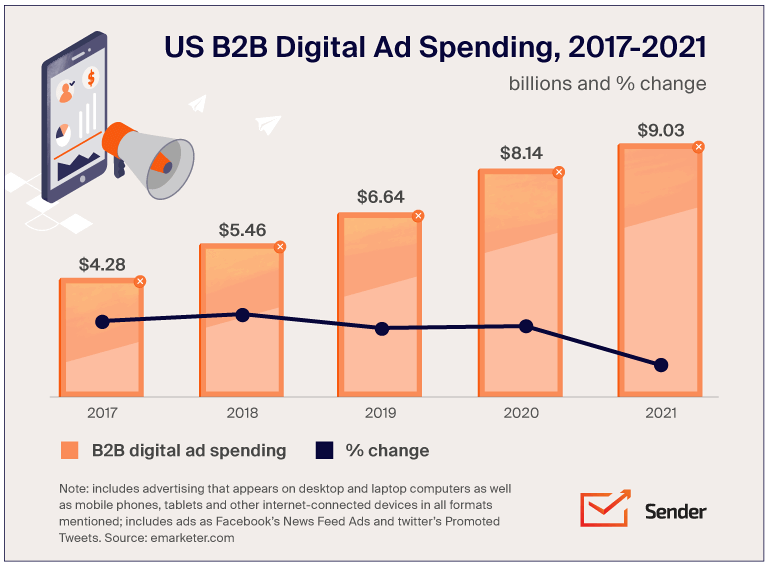
Knowing when and how to use the right digital marketing strategies will significantly keep your company ahead of the competition.
That said, here are four B2B marketing strategies you should not overlook:
Retention marketing — You can achieve this through consistent communication and support, customer training, and customer appreciation.
Video marketing — Video content will help your customers visualize the buying process. For example, 70% of B2B buyers watch videos when researching a company and its offerings.
Interactive content — This will help you understand your customer’s tastes and habits. Use social media, infographics, videos, and other relevant info to give your customers more details about your company.
Buyer experience — Use immersive digital experiences based on generational demographics to tap into your audience’s lifestyles and purchasing habits, especially those immersed in a digital-first environment.
B2B Content Marketing
Content marketing has a significant ROI.
According to Statista, 30% of marketers say content has the “highest ROI” of any channel.
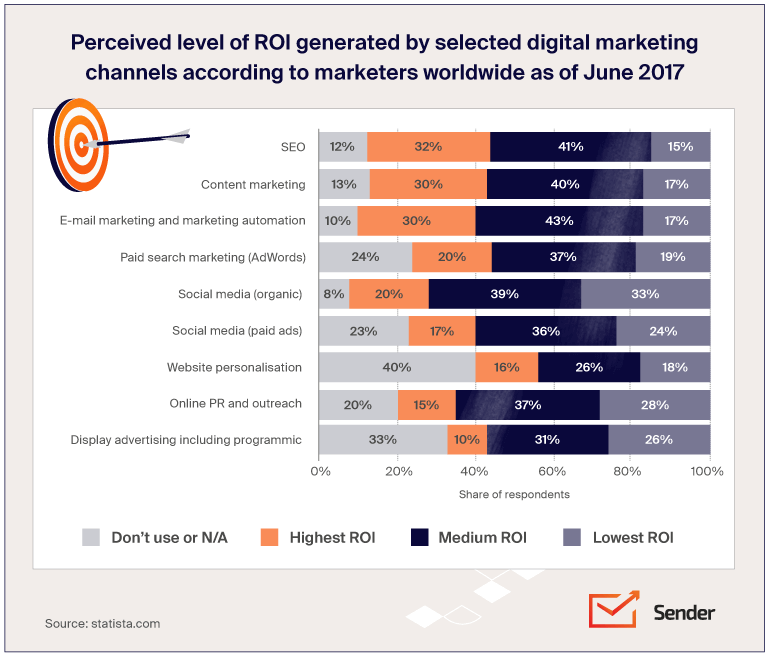
This is why 91% of B2B marketers use content to spread the word about their businesses.
B2B companies usually rely on specific types of content channels. For example, B2B businesses tend to distribute their content via email, blogs, conferences, webinars, PDF whitepapers, and case studies instead of Facebook and Twitter.
Research backs this up. Martech shares that 70% of B2B customers consume content directly from a vendor’s website.
That said, here are four B2B content marketing strategies you can use in your business:
- Send out weekly newsletters
- Create complete guides
- Invest in B2B video content
- Publish industry studies
B2B Social Media Marketing
Do you have a social media strategy for your B2B brand? If not, you’re losing valuable relationship-building opportunities that can lead to lucrative contracts.
Content Marketing Institute shares that a staggering 83% of B2B marketers use social media advertising.
Building a solid B2B social media plan is crucial for short-term benefits and long-term growth. 60% of the most successful B2B content marketers have a content marketing plan. Compare that to only 21% of the least successful.
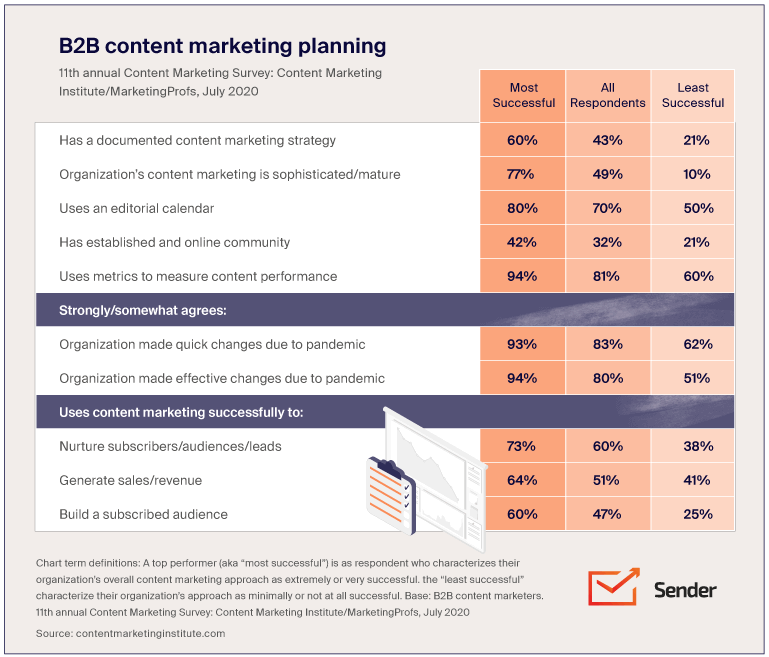
That said, here are four ways you can craft a B2B social media plan for your business and get into that “most successful” category:
- Align goals with business objectives: create brand awareness, educate audiences, and build credibility and trust.
- Use social listening to learn what’s happening on social networks within your industry.
- Get personal by incorporating B2B social media marketing best practices and buyer personas.
- Use the proper social media platforms. As we mentioned earlier, almost all B2B content marketers use LinkedIn. They also rated it as the best organic platform.
Invest in B2B Marketing to Increase Your Customer Base
B2B marketing is effective if you keep your audience in mind. Your message should communicate how your company can help your business customers. And one way to do so is using email marketing.
Email marketing has many moving parts, and manually performing these tasks can be tedious, time-consuming, and ineffective.
You can easily automate these tasks with Sender. Rated as one of 2021’s Top Email Marketing Automation Software by Capterra, Sender offers highly affordable monthly packages (including FREE SMSes for higher plans).
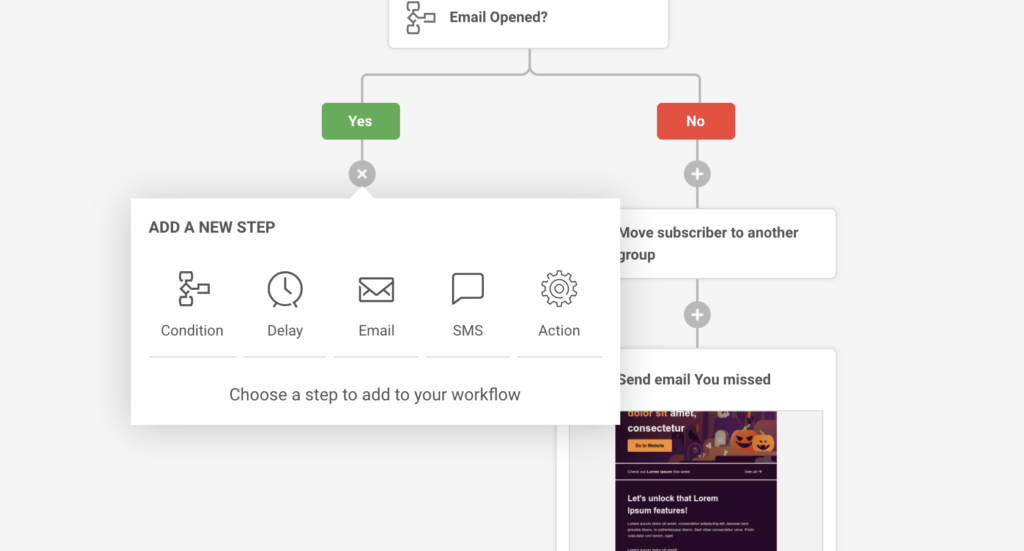
Multichannel automation combines email + SMS channels and is a great way to create compelling customer journeys and effective campaigns. You can also sign up for the Free Forever plan and send up to 15,000 monthly emails for free. Registration takes only a few minutes. No hidden fees or credit cards are required.
Content Contributor – Billy Njogu
